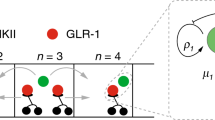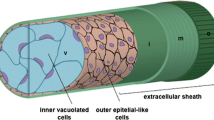Abstract
It is currently thought that the mechanism underlying somitogenesis is linked to a molecular oscillator, the segmentation clock, and to gradients of signaling molecules within the paraxial mesoderm. Here, we review the current picture of this segmentation clock and gradients, and use this knowledge to critically ask: What is the basis for periodicity and directionality of somitogenesis?

Similar content being viewed by others
References
Aulehla A, Herrmann BG (2004) Segmentation in vertebrates: clock and gradient finally joined. Genes Dev 18:2060–2067
Aulehla A, Wehrle C, Brand-Saberi B, Kemler R, Gossler A, Kanzler B, Herrmann BG (2003) Wnt3a plays a major role in the segmentation clock controlling somitogenesis. Dev Cell 4:395–406
del Barco Barrantes I, Elia A, Wunnsch K, Hrabde De Angelis M, Mak T, Rossant J, Conlon R, Gossler A, Luis de la Pompa J (1999) Interaction between Notch signalling and lunatic fringe during somite boundary formation in the mouse. Curr Biol 9:470–480
Bessho Y, Kageyama R (2003) Oscillations, clocks and segmentation. Curr Opin Genet Dev 13:379–384
Bessho Y, Hirata H, Masamizu Y, Kageyama R (2003) Periodic repression by the bHLH factor Hes7 is an essential mechanism for the somite segmentation clock. Genes Dev 17:1451–1456
Christ B, Jacob HJ, Jacob M (1974) Somitogenesis in the chick embryo. Determination of the segmentation direction. Verh Anat Ges 68:573–579
Conlon RA, Reaume AG, Rossant J (1995) Notch1 is required for the coordinate segmentation of somites. Development 121:1533–1545
Del Corral RD, Storey KG (2004) Opposing FGF and retinoid pathways: a signalling switch that controls differentiation and patterning onset in the extending vertebrate body axis. Bioessays 26:857–869
Deuchar E, Burgess AMC (1967) Somite segmentation in amphibian embryos: is there a transmitted control mechanism? J Embryol Exp Morphol 17:349–358
Dubrulle J, McGrew MJ, Pourquie O (2001) FGF signaling controls somite boundary position and regulates segmentation clock control of spatiotemporal Hox gene activation. Cell 106:219–232
Evrard YA, Lun Y, Aulehla A, Gan L, Johnson RL (1998) lunatic fringe is an essential mediator of somite segmentation and patterning. Nature 394:377–381
Galceran J, Sustmann C, Hsu SC, Folberth S, Grosschedl R (2004) LEF1-mediated regulation of delta-like1 links Wnt and Notch signaling in somitogenesis. Genes Dev 18:2718–2723
Greco TL, Takada S, Newhouse MM, McMahon JA, McMahon AP, Camper SA (1996) Analysis of the vestigial tail mutation demonstrates that Wnt-3a gene dosage regulates mouse axial development. Genes Dev 10:313–324
Hirata H, Bessho Y, Kokubu H, Masamizu Y, Yamada S, Lewis J, Kageyama R (2004) Instability of Hes7 protein is crucial for the somite segmentation clock. Nat Genet 36:750–754
Hofmann M, Schuster-Gossler K, Watabe-Rudolph M, Aulehla A, Herrmann BG, Gossler A (2004) WNT signaling, in synergy with T/TBX6, controls Notch signaling by regulating Dll1 expression in the presomitic mesoderm of mouse embryos. Genes Dev 18:2712–2717
Horikawa K, Ishimatsu K, Yoshimoto E, Kondo S, Takeda H (2006) Noise-resistant and synchronized oscillation of the segmentation clock. Nature 441:719–723
Hrabe de Angelis M, McIntyre J, Gossler A (1997) Maintenance of somite borders in mice requires the delta homologue DII1. Nature 386:717–721
Huppert SS, Ilagan MX, De Strooper B, Kopan R (2005) Analysis of Notch function in presomitic mesoderm suggests a gamma-secretase-independent role for presenilins in somite differentiation. Dev Cell 8:677–688
Ishikawa A, Kitajima S, Takahashi Y, Kokubo H, Kanno J, Inoue T, Saga Y (2004) Mouse Nkd1, a Wnt antagonist, exhibits oscillatory gene expression in the PSM under the control of Notch signaling. Mech Dev 121:1443–1453
Jiang YJ, Aerne BL, Smithers L, Haddon C, Ish-Horowicz D, Lewis J (2000) Notch signalling and the synchronization of the somite segmentation clock. Nature 408:475–479
Kawakami Y, Raya Y, Marina Raya Y, Rodríguez-Esteban C, Izpisúa Belmonte J (2005) Retinoic acid signalling links left-right asymmetric patterning and bilaterally symmetric somitogenesis in the zebrafish embryo. Nature (in press)
Lewis J (2003) Autoinhibition with transcriptional delay: a simple mechanism for the zebrafish somitogenesis oscillator. Curr Biol 13(16):1398–1408
Liu P, Wakamiya M, Shea MJ, Albrecht U, Behringer RR, Bradley A (1999) Requirement for Wnt3 in vertebrate axis formation. Nat Genet 22:361–365
Maruhashi M, Van De Putte T, Huylebroeck D, Kondoh H, Higashi Y (2005) Involvement of SIP1 in positioning of somite boundaries in the mouse embryo. Dev Dyn 234:332–338
Masamizu Y, Ohtsuka T, Takashima Y, Nagahara H, Takenaka Y, Yoshikawa K, Okamura H, Kageyama R (2006) Real-time imaging of the somite segmentation clock: revelation of unstable oscillators in the individual presomitic mesoderm cells. Proc Natl Acad Sci USA 103:1313–1318
Menkes B, Sandor S, Elias S (1968) Researches on the formation of axial organs of the chick embryo. IV. Rev Roum Embryol Cytol 5:131–137
Nakaya MA, Biris K, Tsukiyama T, Jaime S, Rawls JA, Yamaguchi TP (2005) Wnt3alinks left-right determination with segmentation and anteroposterior axis elongation. Development 132:5425–5436
Oka C, Nakano T, Wakeham A, de la Pompa JL, Mori C, Sakai T, Okazaki S, Kawaichi M, Shiota K, Mak TW, Honjo T (1995) Disruption of the mouse RBP-J kappa gene results in early embryonic death. Development 121:3291–3301
Packard DSJ (1978) Chick somite determination: the role of factors in young somites and the segmental plate. J Exp Zool 203:295–306
Palmeirim I, Henrique D, Ish-Horowicz D, Pourquié O (1997) Avian hairy gene expression identifies a molecular clock linked to vertebrate segmentation and somitogenesiss. Cell 91:639–648
Palmeirim I, Dubrulle J, Henrique D, Ish-Horowicz D, Pourquié O (1998) Uncoupling segmentation and somitogenesis in the chick presomitic mesoderm. Dev Genet 23:77–85
Pittendrigh CS (1954) On temperature independence in the clock system controlling emergence time in drosophila. Proc Natl Acad Sci USA 40:1018–1029
Pourquie O (2003) Vertebrate somitogenesis: a novel paradigm for animal segmentation? Int J Dev Biol 47:597–603
Saga Y, Takeda H (2001) The making of the somite: molecular events in vertebrate segmentation. Nat Rev Genet 2:835–845
Satoh W, Gotoh T, Tsunematsu Y, Aizawa S, Shimono A (2006) Sfrp1 and Sfrp2 regulate anteroposterior axis elongation and somite segmentation during mouse embryogenesis. Development 133:989–999
Sirbu IO, Duester G (2006) Retinoic-acid signalling in node ectoderm and posterior neural plate directs left-right patterning of somitic mesoderm. Nat Cell Biol 8:271–277
Stern CD, Fraser SE, Keynes RJ, Primmett DR (1988) A cell lineage analysis of segmentation in the chick embryo. Development 104:231–244
Takada S, Stark KL, Shea MJ, Vassileva G, McMahon JA, McMahon AP (1994) Wnt-3a regulates somite and tailbud formation in the mouse embryo. Genes Dev 8:174–189
Tam PP (1981) The control of somitogenesis in mouse embryos. J.Embryol.Exp Morphol 65(Suppl):103–128
Vermot J, Pourquie O (2005) Retinoic acid coordinates somitogenesis and left-right patterning in vertebrate embryos. Nature 435:215–220
Vermot J, Gallego Llamas J, Fraulob V, Niederreither K, Chambon P, Dolle P (2005) Retinoic acid controls the bilateral symmetry of somite formation in the mouse embryo. Science 308(5721):563–566
Yamaguchi TP, Harpal K, Henkemeyer M, Rossant J (1994) fgfr-1 is required for embryonic growth and mesodermal patterning during mouse gastrulation. Genes Dev 8:3032–3044
Yu HM, Jerchow B, Sheu TJ, Liu B, Costantini F, Puzas JE, Birchmeier W, Hsu W (2005) The role of Axin2 in calvarial morphogenesis and craniosynostosis. Development 132:1995–2005
Zhang N, Gridley T (1998) Defects in somite formation in lunatic fringe-deficient mice.Nature 394:374–377
Acknowledgment
A. A was funded by the Swiss Foundation for medical-biological grants. Current work is supported by the Stowers Institute for Medical Research and NIH grant 1R01 HD043158-01. O. P. is a Howard Hughes Medical Institute Investigator.
Author information
Authors and Affiliations
Corresponding author
Rights and permissions
About this article
Cite this article
Aulehla, A., Pourquié, O. On periodicity and directionality of somitogenesis. Brain Struct Funct 211 (Suppl 1), 3–8 (2006). https://doi.org/10.1007/s00429-006-0124-y
Accepted:
Published:
Issue Date:
DOI: https://doi.org/10.1007/s00429-006-0124-y




